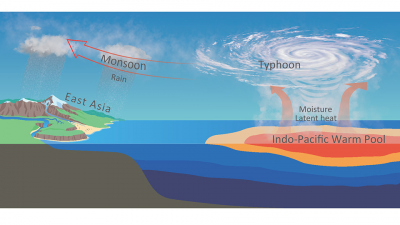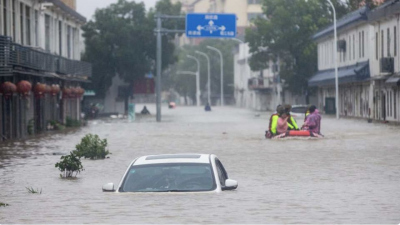- Home
- Discover
- Media Releases
- Media Releases 2022
- obere Ozeanschichten
Ocean Heating Will Increase Rainfall in East Asia, Study Suggests

Recent increases in ocean heat content – where energy is absorbed by the waters – have been implicated in the intensification of tropical storms that draw their energy from the surface of the ocean. The link between ocean heating and rainfall on land is, however, less clear. A study published in Nature provides insight into this link.
“Our study suggests variations in ocean thermal structure affect the delivery of moisture, latent heat, and what happens when they arrive on land,” said Mahyar Mohtadi, head of the research group "Low-Latitude Climate Variability" at MARUM – Center for Marine Environmental Sciences, University of Bremen.
Mohtadi said the changes in the latitudinal temperature gradient – the difference in sea-surface temperature between low and high latitudes – not only control how energy is absorbed by the equatorial upper ocean but how winds carry the moisture from the ocean onto land.
The study, led by Zhimin Jian of Tongji University in China, found that over the past 360,000 years, increases in monsoonal rain in eastern China correlated with increases in the heat content of the Indo-Pacific Warm Pool–a region where sea surface temperatures remain above ~28°C year-round–likely due to enhanced transport of moisture and latent heat absorbed in the water vapor from the ocean to the continent.
According to the study, the changes in upper ocean heat content follow shifts in the Earth’s orbit that occur about every 23,000 years and change the distribution of incoming solar radiation at each latitude.
By using two foraminifera species, calcareous marine organisms, one a surface dweller and the other that lives approximately 200 meters below the sea surface, the scientists reconstructed how the upper ocean thermal structure gets its heat and energy. They compared their results with reconstructions of the monsoonal precipitation in eastern Asia for the same period.
The coupling of ocean heat content and monsoon variations, both coordinated by insolation changes at astronomical timescales, is critical for regulating the global hydroclimate, the researchers said.
Co-authors include Zhimin Jian, Yue Wang, Haowen Dang, Zhongfang Liu, Haiyan Jin, Liming Ye, Xingxing Wang of Tongji University, Shanghai;Yair Rosenthal of Rutgers University, New Brunswick; David Lea of the University of California, Santa Barbara; and Wolfgang Kuhnt of Christian-Albrechts-University, Kiel.
Contact:
PD Dr. Mahyar Mohtadi
MARUM - Center for Marine and Environmental Sciences, University of Bremen
Low-Latitude Climate Variability
Phone: +49 (0)421 - 218 65660
E-mail: [Bitte aktivieren Sie Javascript]
MARUM produces fundamental scientific knowledge about the role of the ocean and the ocean floor in the total Earth system. The dynamics of the ocean and the ocean floor significantly impact the entire Earth system through the interaction of geological, physical, biological and chemical processes. These influence both the climate and the global carbon cycle, and create unique biological systems. MARUM is committed to fundamental and unbiased research in the interests of society and the marine environment, and in accordance with the Sustainable Development Goals of the United Nations. It publishes its quality-assured scientific data and makes it publicly available. MARUM informs the public about new discoveries in the marine environment and provides practical knowledge through its dialogue with society. MARUM cooperates with commercial and industrial partners in accordance with its goal of protecting the marine environment.
Zhimin Jian, Yue Wang, Haowen Dang, Mahyar Mohtadi, Yair Rosenthal, David W. Lea, Zhongfang Liu, Haiyan Jin, Liming Ye, Wolfgang Kuhnt & Xingxing Wang: Warm pool ocean heat content regulates ocean–continent moisture transport. Nature 2022. DOI: 10.1038/s41586-022-05302-y.
More information:
Working Group "Low-Latitude Climate Variability" at MARUM



